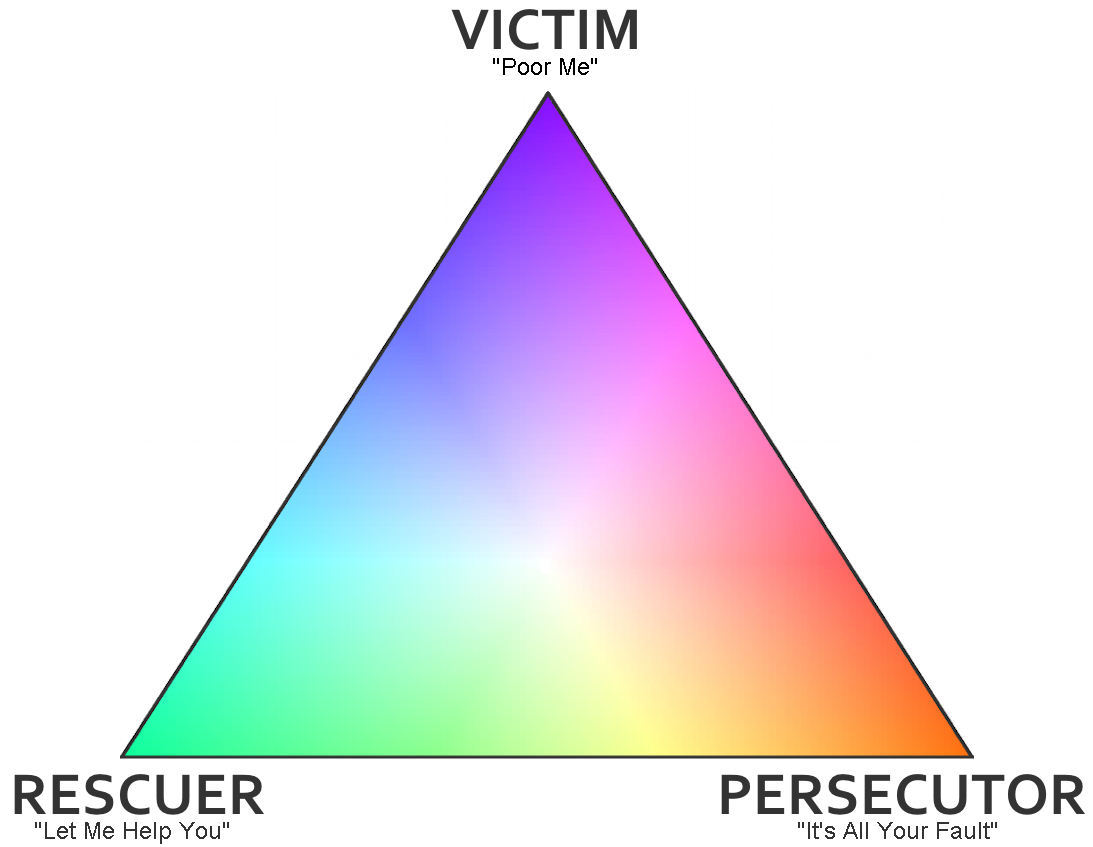Drama Triangle: Enhancing Victimhood with Vengeance and Sacrifice
I don't denounce structuralism. Every time I watch a Disney or Pixar movie with my daughters and tears start welling up in my eyes by simple structural tactics, like music and camera angles, I'm reminded there is a reason it works. But I'm a literary writer and we are defiant bastards and we like to take structuralism and bend it our will. So we can look in the mirror and say to ourselves, "The industry will not make me a slave." The above diagram is one of the tools I use to write fiction. I learned this from an adjunct professor at the Institute of American Indian Arts, where I obtained my BFA in Creative Writing. It has helped tremendously. I use it over and over and weigh each character against it.So to create a dynamic character in your story, you have to apply all three to your main characters, including the antagonist. This will have your character looking three dimensional, like a real human being. Easy enough.But I'm a nerd and a writerly nerd at that so I think about writing often and techniques and how they're applicable to what I'm working on. Right now, I'm revising my first novel so I spend a lot of time thinking about the above diagram.Mostly, of recent, I've been thinking of the victim dimension, and it, like the other two, can appear to be straight forward. Then I start to ask: What kind of victim? How many victim types can there be? Then I start to make an interesting list. There is the wallow in self pity victim. There is the weaponize my victimhood victim. There is the vengeful victim. And then there is the savior victim.What I've come to find is a character is more dynamic and interesting and resonates when the character can exhibit as many traits of the victim as possible. Why? For the same reason you want your main character to have all three dimensions in the diagram above, because it makes them appear more complex, more real, more human.What is more interesting to me is that when you mix victim with the rescuer you get the savior victim (those who have been violated and have returned to rescue you from your own brutality), and when you mix victim with the persecutor you get the vengeful victim (those who have been violated and have returned to make you pay). The main character in my novel, Dean, plays victim/rescuer to certain individuals in the novel, but toward the antagonist he plays victim/persecutor.But what makes me most excited about my novel is when Dean exacts vengeance on the antagonist he is doing it in the name of all the victims the antagonist has metaphorically killed in the novel, so subsequently he blends rescuer and persecutor. More or less, he throws himself on a grenade.What are your thoughts? How might you blend the three different roles listed above? Have you applied the drama triangle to your writing? What was the outcome?(Works Cited: The above image was borrowed from Wikimedia commons.)
The above diagram is one of the tools I use to write fiction. I learned this from an adjunct professor at the Institute of American Indian Arts, where I obtained my BFA in Creative Writing. It has helped tremendously. I use it over and over and weigh each character against it.So to create a dynamic character in your story, you have to apply all three to your main characters, including the antagonist. This will have your character looking three dimensional, like a real human being. Easy enough.But I'm a nerd and a writerly nerd at that so I think about writing often and techniques and how they're applicable to what I'm working on. Right now, I'm revising my first novel so I spend a lot of time thinking about the above diagram.Mostly, of recent, I've been thinking of the victim dimension, and it, like the other two, can appear to be straight forward. Then I start to ask: What kind of victim? How many victim types can there be? Then I start to make an interesting list. There is the wallow in self pity victim. There is the weaponize my victimhood victim. There is the vengeful victim. And then there is the savior victim.What I've come to find is a character is more dynamic and interesting and resonates when the character can exhibit as many traits of the victim as possible. Why? For the same reason you want your main character to have all three dimensions in the diagram above, because it makes them appear more complex, more real, more human.What is more interesting to me is that when you mix victim with the rescuer you get the savior victim (those who have been violated and have returned to rescue you from your own brutality), and when you mix victim with the persecutor you get the vengeful victim (those who have been violated and have returned to make you pay). The main character in my novel, Dean, plays victim/rescuer to certain individuals in the novel, but toward the antagonist he plays victim/persecutor.But what makes me most excited about my novel is when Dean exacts vengeance on the antagonist he is doing it in the name of all the victims the antagonist has metaphorically killed in the novel, so subsequently he blends rescuer and persecutor. More or less, he throws himself on a grenade.What are your thoughts? How might you blend the three different roles listed above? Have you applied the drama triangle to your writing? What was the outcome?(Works Cited: The above image was borrowed from Wikimedia commons.)